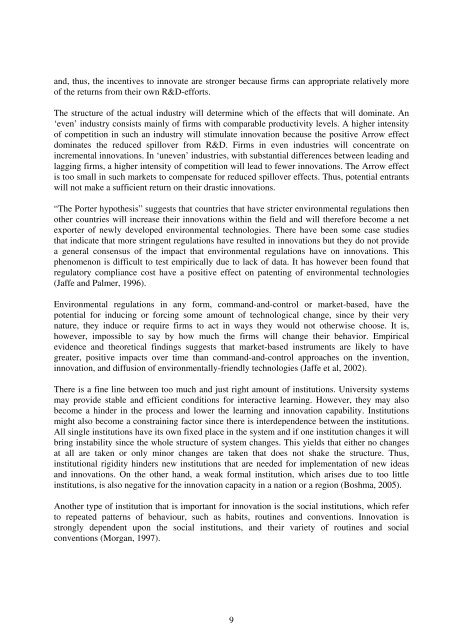INNOVATION POLICY INSTRUMENTS
INNOVATION POLICY INSTRUMENTS
INNOVATION POLICY INSTRUMENTS
You also want an ePaper? Increase the reach of your titles
YUMPU automatically turns print PDFs into web optimized ePapers that Google loves.
and, thus, the incentives to innovate are stronger because firms can appropriate relatively more<br />
of the returns from their own R&D-efforts.<br />
The structure of the actual industry will determine which of the effects that will dominate. An<br />
‘even’ industry consists mainly of firms with comparable productivity levels. A higher intensity<br />
of competition in such an industry will stimulate innovation because the positive Arrow effect<br />
dominates the reduced spillover from R&D. Firms in even industries will concentrate on<br />
incremental innovations. In ‘uneven’ industries, with substantial differences between leading and<br />
lagging firms, a higher intensity of competition will lead to fewer innovations. The Arrow effect<br />
is too small in such markets to compensate for reduced spillover effects. Thus, potential entrants<br />
will not make a sufficient return on their drastic innovations.<br />
“The Porter hypothesis” suggests that countries that have stricter environmental regulations then<br />
other countries will increase their innovations within the field and will therefore become a net<br />
exporter of newly developed environmental technologies. There have been some case studies<br />
that indicate that more stringent regulations have resulted in innovations but they do not provide<br />
a general consensus of the impact that environmental regulations have on innovations. This<br />
phenomenon is difficult to test empirically due to lack of data. It has however been found that<br />
regulatory compliance cost have a positive effect on patenting of environmental technologies<br />
(Jaffe and Palmer, 1996).<br />
Environmental regulations in any form, command-and-control or market-based, have the<br />
potential for inducing or forcing some amount of technological change, since by their very<br />
nature, they induce or require firms to act in ways they would not otherwise choose. It is,<br />
however, impossible to say by how much the firms will change their behavior. Empirical<br />
evidence and theoretical findings suggests that market-based instruments are likely to have<br />
greater, positive impacts over time than command-and-control approaches on the invention,<br />
innovation, and diffusion of environmentally-friendly technologies (Jaffe et al, 2002).<br />
There is a fine line between too much and just right amount of institutions. University systems<br />
may provide stable and efficient conditions for interactive learning. However, they may also<br />
become a hinder in the process and lower the learning and innovation capability. Institutions<br />
might also become a constraining factor since there is interdependence between the institutions.<br />
All single institutions have its own fixed place in the system and if one institution changes it will<br />
bring instability since the whole structure of system changes. This yields that either no changes<br />
at all are taken or only minor changes are taken that does not shake the structure. Thus,<br />
institutional rigidity hinders new institutions that are needed for implementation of new ideas<br />
and innovations. On the other hand, a weak formal institution, which arises due to too little<br />
institutions, is also negative for the innovation capacity in a nation or a region (Boshma, 2005).<br />
Another type of institution that is important for innovation is the social institutions, which refer<br />
to repeated patterns of behaviour, such as habits, routines and conventions. Innovation is<br />
strongly dependent upon the social institutions, and their variety of routines and social<br />
conventions (Morgan, 1997).<br />
9
















